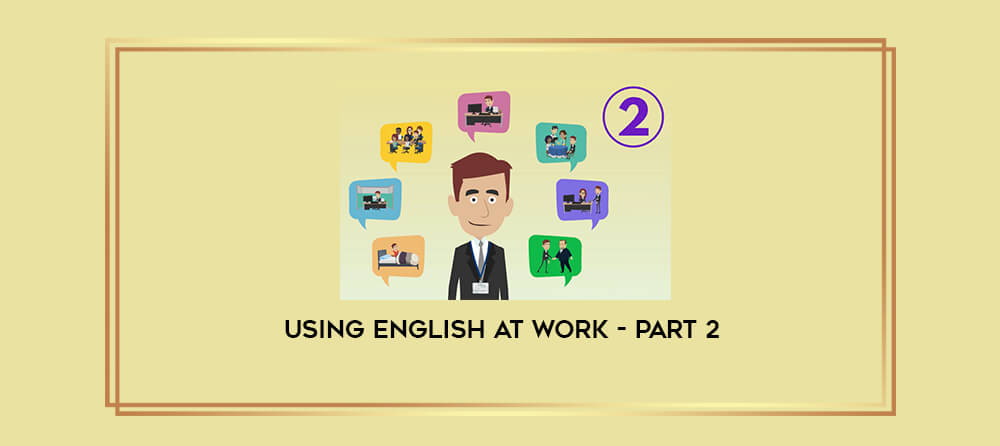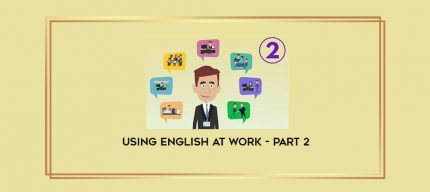Using English at Work – Part 2
Course Description
Archive : Using English at Work – Part 2 Digital Download
Salepage : Using English at Work – Part 2
Delivery : Online With Any Device
Do you ever get nervous speaking English with your co-workers?
Are you often unsure about the -right word or expression to use at work?
Do you want to speak to co-workers with ease and confidence?
Get serious about improving your business English. This two-part course helps you learn commonly used words and phrases that you need to succeed in English at work. In each lesson, you’ll learn common and useful vocabulary for everyday situations found in an office.
The course includes two sets of five detailed lessons (10 lessons total in the two-part course) that describe each part of a typical workday. Learn vocabulary related to arriving at work, checking mail and email, attending office meetings, going to business lunches, handling computer problems, scheduling a meeting, meeting with your boss, and socializing with coworkers.
After listening to Using English at Work, you will be better able to speak and write business English. Get it right with this complete course in daily English for businesspeople like you!
Course Length (Part 2) — 2.25 hours (1.75 hours video + text)
Lessons Included
(Note: Be sure to get Part 1 before starting on Part 2)
Lesson 1 – Having Computer Problems
Almost no one works without a computer anymore, and almost everyone has computer problems! Learn the most common ones and how to describe them in this lesson. Included in this lesson:
Common computer vocabulary, such as -mouse and -keyboard
Several different problems you might have with your computer
Idioms including -make headway, -acting up, and -a mile a minute
What happens when you call the -computer tech to help fix things
Lesson 2 – Scheduling a Meeting
If you’re not in a meeting every day, you’re probably planning one. Learn how to talk about scheduling a meeting with a co-worker, customer, or client in this lesson. Included in this lesson:
Different ways a person might schedule, or -set up, a meeting
The meaning and origin of the phrase -playing phone tag
Common idioms such as -the earlier the better and -free and clear
The difference between being -tied up and -free
Lesson 3 – Meeting with the Boss
Will your boss say good things to you at your next one-to-one meeting or bad things? Find out how to tell the difference in English in this lesson. Included in this lesson:
Useful workplace terms such as -update, -progress, and -raise
The difference between a -heads up and -to keep your head down
The common American custom of -shaking hands
Idioms including -to get a pat on the back and -to jump the gun
Lesson 4 – Leaving Work
It’s quitting time! But don’t relax until you’ve learned some commons phrases and terms for getting ready to leave your desk and go back home. Included in this lesson:
The meaning of the popular term -quitting time
An explanation of the idiom -to burn the midnight oil
Vocabulary related to leaving the office for the weekend
The phrase -here I come – and the song it comes from
Lesson 5 – Socializing with Coworkers
Okay, so you’re not going home right away. You want to go out and enjoy life with your fellow employees. This lesson takes you to your local bar or restaurant for some after-work drinks. Included in this lesson:
An explanation of the American custom known as -happy hour
The types of happy hour food served at many restaurants
Advice on when it might be smart -to change the subject
The difference between -to kick back and -to kick off
Course Curriculum
Lesson 0: How to Use This Course
PreviewHow to Use This Course to Learn English Fast! (1:38)
Lesson 1: Having Computer Problems
StartA. Story Video (Slow) (2:24)
StartB. Explanation, Part 1 (5:38)
StartC. Explanation, Part 2 (5:00)
StartD. Explanation, Part 3 (5:10)
StartE. Story Video (Fast) (1:34)
StartF. Glossary
StartG. Quiz (Optional)
StartH. Complete Transcript Review (Optional)
Lesson 2: Scheduling a Meeting
StartA. Story Video (Slow) (1:48)
StartB. Explanation, Part 1 (3:12)
StartC. Explanation, Part 2 (5:59)
StartD. Explanation, Part 3 (5:11)
StartE. Story Video (Fast) (1:10)
StartF. Glossary
StartG. Quiz (Optional)
StartH. Complete Transcript Review (Optional)























Reviews
There are no reviews yet.